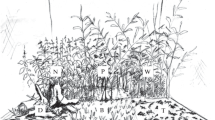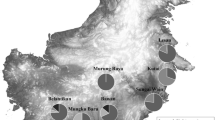Abstract
Between the rainy season months of July and November 1976, the author censused and intensively studied for 50 hr the capped langur,Presbytis pileatus, in the Madhupur Forest, Bangladesh. Transects were made in the forest to provide tree girth and height measurements. The predominant tree species is sal,Shorea robusta. The mean group size for capped langur troops observed in excess of 1 hr was 8.7, and that for troops censused for less than 1 hr, 7.5. Troops were primarily unimale, but one all-male band of four and a solitary adult male were sighted. The adult sex ratio of females to males was 2:1. The equivalent ecological density for intensively studied troops was 92 individuals/km2. Estimated ecological biomass was equal to 716.5 kg/km2. A daily activity profile shows that the capped langur has a bimodal feeding schedule. Midday is clearly a rest period. Adult males spend much time in sentinel behavior and an unusual penile display is described. Instances of intergroup antagonism are detailed. Fighting was observed on one occasion. Vocalizations are described by context of emission.
Similar content being viewed by others
References
Ahmad, N. (1968).An Economic Geography of East Pakistan, 2nd ed. Oxford University Press, London.
Altmann, J. (1974). Observational study of behavior: Sampling methods.Behaviour 49: 227–265.
Blanford, W. T. (1888).The Fauna of British India, Including Burma and Ceylon: Mam-malia, Taylor and Francis, London.
Champion, H. G. (1933). Regeneration and management of sal (Shorea robusta).Ind. For. Rec. 19: 1–155.
Chivers, D. J. (1974). The siamang in Malaya: A field study of a primate in a tropical rain forest.Contr. Primatol. 4: 1–335.
Chowdhury, A. M. (1973).Working Scheme for the Mymensingh Division, 1969-70, Bangladesh Government Press, Dacca.
Crook, J. H., and Aldrich-Blake, P. (1968). Ecological and behavioral contrasts between sym-patric ground dwelling primates in Ethiopia.Folia Primatol. 8: 192–227.
Eisenberg, J. F. (1979). Habitat, economy, and society: Some correlations and hypotheses for the Neotropical primates. In Bernstein, I. S., and Smith, E. O. (eds.),Primate Ecology and Human Origins, Garland Press, New York.
Green, K. M. (1977). Primate resources of Bangladesh.Lab. Prim. Newsl. 16(4): 1–8.
Green, K. M. (1978). Primates of Bangladesh: A preliminary survey of population and habitat.Biol. Conserv. (13): 141–160.
Green, K. M. (1981). Digital processing of tropical forest habitat in Bangladesh and the development of a low cost processing facility at the National Zoo, Smithsonian Institution. Proc. 15th Int. Symp. on Remote Sensing of the Environment.
Hinton, M. A. C. (1924). Scientific results from the mammal survey No. 36 on the capped langurs (Pithecus pileatus Blyth) and its allies.J. Bombay Nat. Hist. Soc. 29: 77–83.
Hinton, M. A. C., and Lindsay, H. M. (1926). Mammal survey of India, Burma, and Ceylon. Report No. 41, Assam and Mishmi Hills.J. Bombay Nat. Hist. Soc. 31: 383–402.
Hrdy, S. B. (1977).The Langurs of Abu, Harvard University Press, Cambridge, Mass.
Hunter, W. W. (1875).A Statistical Account of Bengal. Vol. V. Districts of Dacca, Bakarganj, Faridpur and Maimansing, Trubner, London.
Johnson, B. L. C. (1975).Bangladesh, Barnes and Noble, New York.
Khajuria, H. (1962a). Some field observations on the habits of the capped langur and the barking deer in the Garo Hills, Assam.Rec. Ind. Mus. 58: 121–122.
Khajuria, H. (1962b). Further observations on the Gee's langur,Presbytis geei, Khajuria, with remarks on the classification of Indian Colobidae (Mammalia: Primates).Rec. Ind. Mus. 58: 123–131.
Kinzey, W. G., Rosenberger, A. L., Heisler, P. S., Prowse, D. L., and Trilling, J. S. (1977). A preliminary field investigation of the yellow handed titi monkey,Callicebus torquatus, in northern Peru.Primates 18: 159–181.
McCann, C. (1933). Observations on some of the Indian langurs.J. Bombay Nat. Hist. Soc. 36:618–628.
Oboussier, H., and Maydell, G. A. von (1959). Zur Kenntnis des indischen Goldlangurs. Ergebnisse der Deutschen Indien-Expedition 1955–1957. Leitung, G. A. Frhr. V. Maydell.Z. Okol. Tiere (Berlin) 58: 102–114.
Pocock, R. (1939).The Fauna of British India, Including Ceylon and Burma: Mammalia. I. Primates and Carnivora (in Part), Families Felidae and Viverridae, 2nd ed., Taylor and Francis, London.
Roonwal, M. L., and Mohnot, S. M. (1977).Primates of South Asia: Ecology, Sociobiology, and Behaviour, Harvard University Press, Cambridge, Mass.
Rudran, R. (1973). Adult male replacement in one-male troops of purple-faced langurs (Presbytis senex senex) and its effect on population structure.Folia Primatol. 19: 166–192.
Rudran, R. (1979). The demography and social mobility of a red howler (Alouatta seniculus) population in Venezuela. In Eisenberg, J. F. (ed.),Vertebrate Ecology in the Northern Neotropics, Smithsonian Institution Press, Washington, D.C., pp. 107–126.
Yoshiba, K. (1968). Local and intertroop variability in ecology and social behavior of com-mon Indian langurs. In Jay, P. (ed.),Primates: Studies in Adaptation and Variability, Holt, Rinehart and Winston, New York.
Author information
Authors and Affiliations
Rights and permissions
About this article
Cite this article
Green, K.M. Preliminary observations on the ecology and behavior of the Capped Langur,Presbytis pileatus, in the Madhupur forest of Bangladesh. Int J Primatol 2, 131–151 (1981). https://doi.org/10.1007/BF02693445
Received:
Revised:
Issue Date:
DOI: https://doi.org/10.1007/BF02693445




